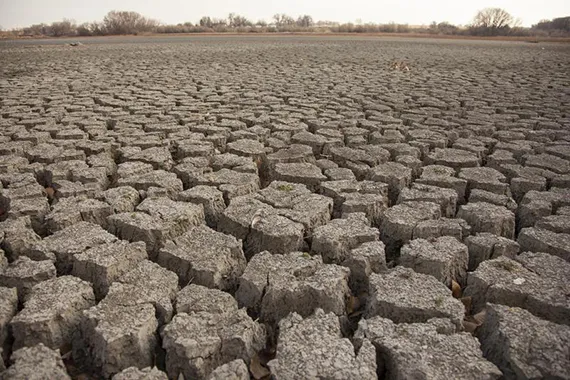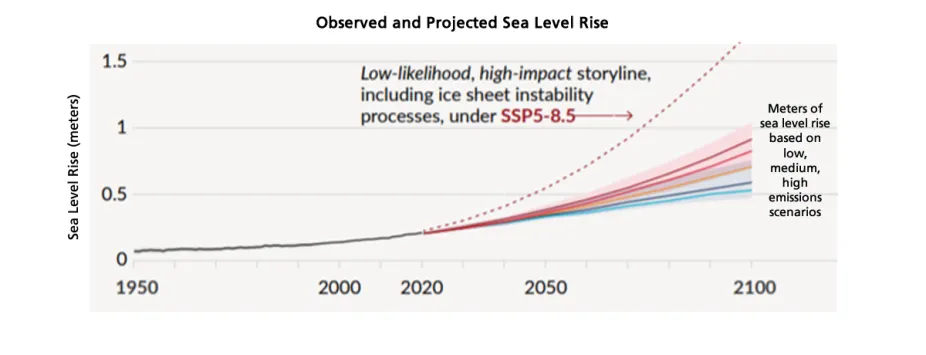The Water Cycle and Climate Change
Water is always on the move. Rain falling today may have been water in a distant ocean days before. And the water you see in a river or stream may have been snow on a high mountaintop. Water is in the atmosphere, on the land, in the ocean, and underground. It moves from place to place through the water cycle, which is changing as climate changes. Below are examples of some changes that are happening as global temperatures rise.
Climate change affects evaporation and precipitation.
Climate change is likely causing parts of the water cycle to speed up as warming global temperatures increase the rate of evaporation worldwide. More evaporation is causing more precipitation, on average. We are already seeing impacts of higher evaporation and precipitation rates, and the impacts are expected to increase over this century as climate warms.
Higher evaporation and precipitation rates are not evenly distributed around the world. Some areas may experience heavier than normal precipitation, and other areas may become prone to droughts, as the traditional locations of rain belts and deserts shift in response to a changing climate. Some climate models predict that coastal regions will become wetter and the middle of continents will become drier. Also, some models forecast more evaporation and rainfall over oceans, but not necessarily over land.
Warmer temperatures associated with climate change and increased carbon dioxide levels may speed plant growth in regions with ample moisture and nutrients. This could lead to increased transpiration, the release of water vapor into the air by plants as a result of photosynthesis.

Mudcracks form during droughts when the ground dries out and moisture evaporates.
NOAA
Changing climate means changing weather.
Climate warming is causing changes to weather in different regions of the world. In particular, it is causing more extreme weather events than we have seen in the past. These extreme weather events can have impacts on human health, limiting access to clean drinking water, food, and shelter and taxing people’s ability to cope with heat, drought or flood.
- More rain and flooding: With more evaporation, there is more water in the air so storms can produce more intense rainfall events in some areas. This can cause flooding – a risk to the environment and human health.
- More extreme drought: Warmer temperatures cause more evaporation, turning water into vapor in the air, and causing drought in some areas of the world. Places prone to drought are expected to become even drier over the next century. This is bad news for farmers who can expect fewer crops in these conditions.
- Stronger hurricanes: Warmer ocean surface waters can intensify hurricanes and tropical storms, leading to more hazardous conditions as these storms make landfall. Scientists continue to research how climate change affects the number of these storms, but we know that the storms will be powerful and destructive in the future.
- Heat waves: It is likely that heat waves have become more common in more areas of the world.
Clouds affect the climate and climate affects the clouds.
Currently, the combined effect of all clouds is one of net cooling, meaning that clouds are dampening the rate of climate warming. But scientists are looking into whether clouds will have the same effect on climate as the Earth continues to warm. If the proportion of different cloud types changes, it could affect the rate of climate change because different types of clouds have different impacts on the Earth's climate. While some types of clouds help to warm the Earth, others help to cool it (as described below). This is an area of ongoing research.
- Learn more: Clouds, Precipitation, and Climate Change
Worldwide, sea level is rising because of climate change.
As of the 2020s, sea levels are 0.10- 0.20 meters (0.30-0.75 feet) higher than they were a century ago because of climate change. Over the 21st century, sea level is expected to rise as much as 1.1 meters (3.6 feet) if greenhouse gas emissions continue at projected levels.

Observed (black line) and projected sea level rise, with the different colored curves corresponding to different emissions scenarios. Even using the lowest emissions scenarios, about a half meter of sea level rise can be expected by 2100. For the higher greenhouse gas emissions scenarios, a global sea level rise of about 1 meter is expected by the end of the century.
IPCC Sixth Assessment Report
There are two ways that our warming climate is causing sea level rise.
First, water from melting glaciers and ice sheets flows down rivers and is added to the ocean. Over the past 100 years mountain glaciers, Arctic glaciers, and Greenland’s ice have decreased dramatically in size. With less ice trapped on land in glaciers and ice sheets, there is more water in the ocean, and sea level is higher. Melting ice that is already in the ocean, like sea ice, has a minor impact on sea level rise.
Second, ocean water expands as it warms, increasing its volume, so the water in the ocean takes up more space and sea level is higher. Since 1955, more than 90% of the excess heat held in the atmosphere by heat-trapping gases has made its way into the ocean. If this didn’t happen, climate warming would be much more dramatic. But because the heat is added to the ocean, and because ocean water expands with heat, sea level rises, flooding coasts. Also, marine life that are sensitive to changes in temperature struggle to survive.
Thermal expansion and melting ice each contributed about half of the recent sea level rise, though there is some uncertainty in the exact magnitude of the contribution from each source. Thermal expansion of seawater is predicted to account for about 75% of future sea level rise according to Earth system models.
Ocean water is warming and growing acidic.
Warmer waters in the shallow oceans have contributed to the death of about a quarter of the world's coral reefs in the last few decades. Many of the coral animals died after weakened by coral bleaching, a process tied directly to warmed waters. Also, corals and other marine life find it more difficult to grow their shells and bones as seawater takes in carbon dioxide from the atmosphere and becomes more acidic.
Sea ice is shrinking, causing more warming.
Each year, the amount of sea ice that covers the Arctic Ocean grows in the winter and then melts at its edges in the summer. But lately, warmer temperatures have caused more ice to melt in the summer and less ice to grow in winter. The summer thickness of sea ice is about half of what it was in 1950. Melting sea ice could cause changes in ocean circulation as the temperature and density of water changes. It is also speeding up warming in the Arctic – with less ice, less sunlight is reflected out to space and more is absorbed by the water and land. Typically, almost all of the sunlight that hits sea ice is reflected back out to space, but as the ice melts, the ocean underneath is exposed, which absorbs more sunlight, causing more climate warming.
- Learn more: Climate and Ice